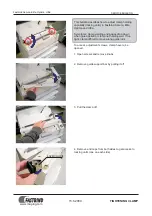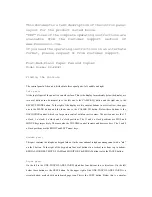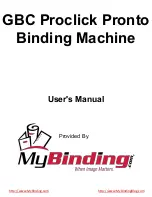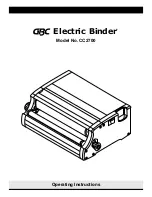
36
KX-FT937LA-B
6.6.2.
Modem Circuit Operation
The modem (IC5) has all the hardware satisfying the CCITT standards mentioned previously.
When the ASIC IC1 (61) is brought to a low level, the modem (IC5) is chip-selected and the resistors inside IC are selected by the
select signals from ASIC (IC1) ADR0-ADR4. The commands are written through the data bus, and all the processing is controlled
by the ASIC (IC1) according to CCITT procedures. The INT signal dispatched from IRQ (pins 100 of IC5) to ASIC (IC1) when the
transmission data is accepted and the received data is demodulated, the ASIC (IC1) implements post processing. This modem
(IC5) has an automatic application equalizer.
With training signal 1 or 2 during G3 reception, it can automatically establish the optimum equalizer. The modem (IC5) operates
using the 32.256 MHz clock (X3).
1.
Facsimile Transmission
The digital image data on the data bus is modulated in the modem (IC5), and sent from pin 69 via Analog SW IC10, amplifier
IC9 and the NCU section to the telephone line.
Refer to
Signal Route
(P.108).
2.
Facsimile Reception
The analog image data which is received from the telephone line passes through the NCU section and enters pin 47 of the
modem (IC5). The signals that enter pin 47 of the modem (IC5) are demodulated in the board to digital image signals, then
placed on the data bus.
In this case, the image signals from the telephone line are transmitted serially. Hence, they are placed on the bus in 8 bit
units. Here, the internal equalizer circuit reduces the image signals to a long-distance receiving level.
This is designed to correct the characteristics of the frequency band centered about 3 kHz and maintain a constant receiving
sensitivity. It can be set in the service mode.
Refer to
Signal Route
(P.108).
3.
DTMF Transmission (Monitor tone)
The DTMF signal generated in the modem (IC5) is output from pin 56, and is then sent to the circuit on the same route as
used for facsimile transmission.
Refer to
Signal Route
(P.108).
(DTMF Monitor Tone)
Refer to
Signal Route
(P.108).
4.
Call Tone Transmission
This is the call signal which is generated in the ASIC (IC1) and sent to the speaker.
Refer to
Signal Route
(P.108).
5.
Busy/Dial Tone Detection
The path is the same as FAX receiving. When it is detected, the carrier detect bit of the resistor in the modem (IC5) becomes
1, and this status is monitored by the ASIC (IC1).
6.
Caller ID Detection
The caller ID signal which is received from the telephone line/passes through IC1 pin (2-1). And it enters pin 50 of the modem
(IC5).
Summary of Contents for KX-FT937LA-B
Page 11: ...11 KX FT937LA B 6 Technical Descriptions 6 1 Connection Diagram ...
Page 21: ...21 KX FT937LA B 6 4 2 Block Diagram ...
Page 23: ...23 KX FT937LA B ...
Page 68: ...68 KX FT937LA B ...
Page 69: ...69 KX FT937LA B CROSS REFERENCE Test Mode P 54 ...
Page 70: ...70 KX FT937LA B CROSS REFERENCE Test Mode P 54 ...
Page 71: ...71 KX FT937LA B CROSS REFERENCE Test Mode P 54 ...
Page 72: ...72 KX FT937LA B CROSS REFERENCE Test Mode P 54 ...
Page 73: ...73 KX FT937LA B ...
Page 74: ...74 KX FT937LA B ...
Page 75: ...75 KX FT937LA B CROSS REFERENCE Test Mode P 54 ...
Page 102: ...102 KX FT937LA B NG Wave pattern Note Refer to NG Example P 107 ...
Page 104: ...104 KX FT937LA B I O and Pin No Diagram ...
Page 106: ...106 KX FT937LA B ...
Page 107: ...107 KX FT937LA B 12 5 5 3 NG Example ...
Page 111: ...111 KX FT937LA B 12 5 7 2 Troubleshooting Flow Chart ...
Page 116: ...116 KX FT937LA B 12 5 11 Thermal Head Section Refer to Thermal Head P 22 ...
Page 117: ...117 KX FT937LA B 13 Service Fixture Tools ...
Page 120: ...120 KX FT937LA B 14 2 Disassembly Procedure 14 2 1 How to Remove the Paper Stacker ...
Page 121: ...121 KX FT937LA B 14 2 2 How to Remove the Operation Panel Block ...
Page 122: ...122 KX FT937LA B 14 2 3 How to Remove the Operation Board LCD and Platen Roller ...
Page 123: ...123 KX FT937LA B 14 2 4 How to Remove the Separation Holder and Document Feed Support ...
Page 124: ...124 KX FT937LA B 14 2 5 How to Remove the Image Sensor CIS and Feed Roller ...
Page 125: ...125 KX FT937LA B 14 2 6 How to Remove the Cutter Unit ...
Page 126: ...126 KX FT937LA B 14 2 7 How to Remove the Lock Lever and Thermal Head ...
Page 127: ...127 KX FT937LA B 14 2 8 How to Remove the Bottom Frame ...
Page 130: ...130 KX FT937LA B 14 2 12 Installation Position of the Lead Wires ...
Page 138: ...138 KX FT937LA B 15 2 3 4 Copying CROSS REFERENCE Sensor Section P 114 ...
Page 142: ...142 KX FT937LA B 16 1 4 Power Supply Board ...
Page 146: ...146 KX FT937LA B Refer to Analog Board Section P 108 ...
Page 147: ...147 KX FT937LA B 16 3 Test Chart 16 3 1 ITU T No 1 Test Chart ...
Page 148: ...148 KX FT937LA B 16 3 2 ITU T No 2 Test Chart ...
Page 155: ...155 KX FT937LA B MEMO ...
Page 165: ...165 KX FT937LA B 20 1 2 Upper Cabinet Section ...
Page 166: ...166 KX FT937LA B 20 1 3 Lower Cabinet Section ...
Page 167: ...167 KX FT937LA B 20 1 4 Gear Block Section ...
Page 168: ...168 KX FT937LA B 20 1 5 Screws ...
Page 169: ...169 KX FT937LA B 20 1 6 Accessories and Packing Materials ...
















































